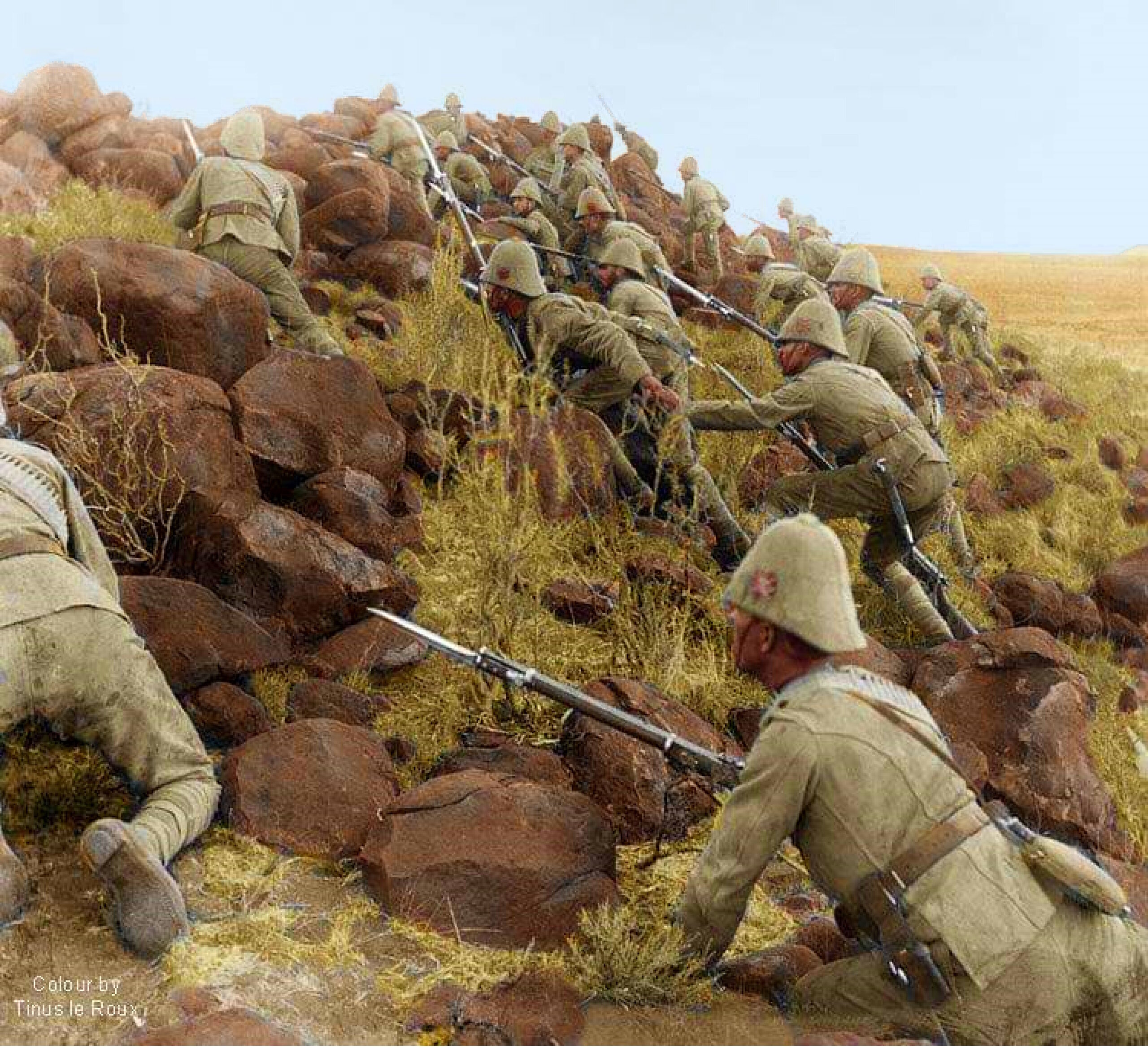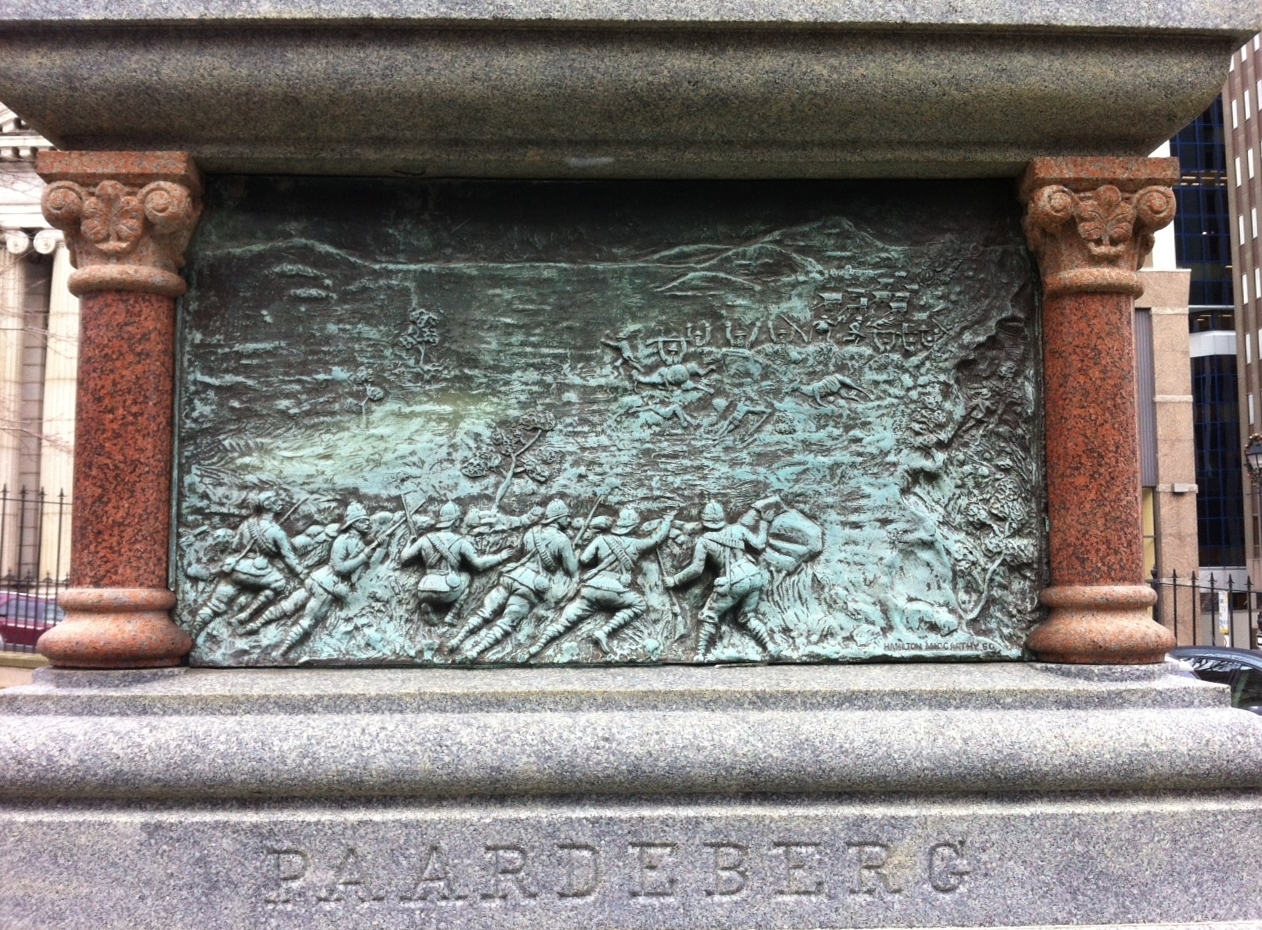
Canadian Troops preparing for attack at Paardeberg. [Wikimedia]
Between Feb. 18 and 27, 1900, one of the most famous clashes of the Boer War resulted in a British Empire victory against the Boers, a victory that would not have been possible without the Canadian contribution in their baptism of fire.
But the South African conflict was not yet over—far from it.
The Battle of Paardeberg indeed reversed the Imperial forces’ fortunes, followed months later by the capture of Bloemfontein and Pretoria—the respective capitals of the enemy’s Orange Free State and South African Republic (or Transvaal).
Nevertheless, the turning tides came at a cost.
Refusing to surrender, the Afrikaans-speaking Boers, descended from Dutch settlers, instead changed tactics, resorting to guerrilla-style warfare against the numerically superior British Empire. These hit-and-run operations relied on small bands of mounted commandos, striking hard before vanishing into the vast veldt.
The British soon deployed similarly mounted units to counter the enemy threat. Among those well suited to the task were the second Canadian contingent.
Having arrived earlier that same year, the formation comprised three Royal Canadian Field Artillery batteries and two mounted regiments: the Royal Canadian Dragoons and the Canadian Mounted Rifles. The Lord Strathcona’s Horse, a regiment privately raised by its namesake financer, had also landed in April.
Each unit endured its own baptism of fire, although more bloodshed awaited.
And so it was, on Nov. 6, 1900, that a British column departed the Transvaal town of Belfast after reports circulated of a Boer commando force camped roughly 30 kilometres to the south near the Komati River. The mounted formation included detachments from the Royal Canadian Dragoons, Canadian Mounted Rifles, and ‘D’ Battery, Royal Canadian Field Artillery, armed with two 12-pounder guns.
Resistance increased as the two sides drew closer to each other. British commander Major-General Horace Smith-Dorrien then decided to make camp for the night.
The chosen site: a farm named Leliefontein.

The South African War Memorial in Halifax depicting the Boer surrender at Paardeberg, with the Royal Canadian Regiment of Infantry depicted in the foreground of the bronze panel. [Wikimedia]
The Boers, reinforced the night before, had been preparing for additional assaults against their positions when they realized their adversaries were pulling back. The counterattack opportunity was too good to miss, especially when there was a fair chance of seizing the Canadian artillery pieces as they covered the withdrawal.
The Canadians, of course, had no intention of letting that happen without a fight. Led by Lieutenant-Colonel François-Louis Lessard, the experienced Dragoons deployed in a defensive line four or five kilometres across at the column’s rear. Located at the centre, meanwhile, were the 12-pounders and Colt machine gun.
The enemy launched a series of cavalry charges to overwhelm the Canadian horsemen and artillerymen. Probing at various points in the line, the attacks culminated in a 200-strong Boer thrust that threatened to break the defence.
Amid the carnage, with an enemy encirclement on the cusp of success, at least three Canadian servicemen went above and beyond in proving their mettle.
The Dragoons’ Lieutenant Hampden Zane Churchill Cockburn was the first of the three to showcase his courage. Less than a month shy of his 33rd birthday, the Toronto native and former barrister led his men into the fray, placing the beleaguered force between the Canadian guns and the attacking Boers.
Most if not all of Cockburn’s troops were lost in the ensuing struggle, and he, too, sustained wounds, but the joint defence kept the artillery out of enemy hands.
Another Boer charge commenced, the commandos firing from the hip as they rode hard toward the Canadian ranks. Twenty-nine-year-old Lieutenant Richard Ernest William Turner, hailing from Quebec City, was to be the second hero of the hour.
Already wounded, Turner, together with a dozen fellow Dragoons, received word that the field guns were still in danger of being captured. The volunteer wasted no time in organizing an ambush that was ultimately able to beat the Boers back.
The Canadian defenders continued to hold the line, helped in no small part by the Colt machine gun spitting rounds as its 22-year-old operator, Sergeant Edward James Gibson Holland, remained at his post between the two artillery pieces.
The Ottawa-born soldier had once belonged to the 5th Princess Louise Dragoon Guards of the militia. Now, fending off tenacious Boer bands in the South African wilderness, his resolve was being put to the test at a critical juncture in the battle.
It was then that the machine gun jammed. Intent on denying the use of his weapon to the enemy, Holland calmly disconnected the red-hot barrel before seizing a horse. He subsequently rode away with the gun nestled beneath his arm.
With two enemy commanders killed in the charge, the increasingly disoriented Boer assault started to lose momentum. The Canadians were at last victorious, although they had suffered some three dead and 11 wounded in the process.
A controversial figure in the field, he was eventually shunted to an administrative role.
Of course, a significant proportion of their overall success was owed to three individuals. Holland, Turner and Cockburn all earned the Victoria Cross.
Cockburn returned to Canada and stayed in the military, serving in the Canadian Reserve of Officers and rising to the rank of major. Unfortunately, he was later killed by a horse at his Saskatchewan ranch on July 12, 1913, at the age of 45.
Turner, who likewise became the recipient of the Distinguished Service Order in South Africa, again served overseas with the Canadian Expeditionary Force during the First World War, where he first commanded 3rd Infantry Brigade, then 2nd Division. A controversial figure in the field, he was eventually shunted to an administrative role. Turner died in Quebec City on June 19, 1961, at age 89.
Holland rejoined his old militia unit of the 5th Princess Louise Dragoon Guards after the Boer War, receiving an officer’s commission. He, too, served in the First World War, leading a motor machine gun battery in France as part of the CEF for one year. He passed away in Cobalt, Ont., on June 18, 194
Advertisement



















